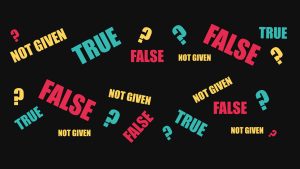
Unlocking IELTS True False Not Given Questions
Hey! Yes, it’s finally here – our episode about IELTS True False Not Given questions! TEN students requested that we have a lesson about this when we asked for listener questions two weeks ago, so I thought we would have a separate episode to go through how you should approach these questions, what you should actually check for when you are reading and, of course, how to choose between false and not given.
This is an interactive lesson – you can download the reading text and questions on this link: https://tinyurl.com/y2z3rps9
The text that we will use today is taken and adapted from the 1st edition of “Focus on IELTS”, which was written by Sue O’Connell, and printed by Pearson. I highly recommend this book for any teacher who is working with IELTS students.
Below, you can find a summary of the episode, which includes links to useful materials and the times of each part of the discussion (so you can go directly to the part you want to listen to) 🚀
Subscribe to My IELTS Classroom podcast on Apple podcasts here
Subscribe to My IELTS Classroom on Google podcasts here
Podcast Summary: Unlocking IELTS True False Not Give questions
00:00 – 04:18 Introduction My IELTS Classroom was voted the best online teaching resource by TED IELTS:
We got some great news this week! My IELTS Classroom was named the number one IELTS Preparation site by TED IELTS. You can read the full review here: https://ted-ielts.com/ielts-website-review/ 🙌🙌 🎉🎉🎉
04:19 – 05:30 IELTS True False Not Give basics
We already have a great introduction to IELTS reading episode, which you may want to go back and listen to before you continue with this one. However, for anybody who hasn’t heard it yet, here are the very basic facts about IELTS True False Not Given questions:
- True False Not Given tasks are designed to check your ability to find and check specific information or opinions
- The questions always appear in the same order as the text – in other words, you NEVER have to go backwards to find the next answer
- There are two forms of question: True /False /Not Given, which test your ability to understand factual information. Yes /No /Not Given, which test your ability to understand the writer’s opinion or view. However, both types of question can be approached in the same way.
- Be careful – the information needed to answer the questions can be spread over two or three sentences. It is a common error to focus on one word or clause. If you cannot find the answer, continue reading – it is likely that you are not yet in the relevant part of the text.
05:31 – 06:39 The TWO types of key words that you have to identify in the question stem
Almost every IELTS student knows that before you read the text, you have to identify “key words” but not many realise that there are actually two types.
06:40 – 16:46 – Scanning words
These are the words that you will use to find the place in the text where the “answer” is located. These are words that are easy to spot and are likely to only be found once or twice in the text (i.e. words that you can be sure will lead you to the lines in the passage that contain the answer). These words are usually (but not always)
- names of people / businesses / organisations
- languages / nationalities / countries / places
- dates / numbers
- technical or scientific words (i.e. a word you don’t recognise and one that may be a specific ‘term’)
16:47 – 22:07 – How to decide if the answer is False or Not Given?
I guess that this the million pound question. So many students struggle with this and yet the way to determine ANY of the options is to ask yourself the simple question – do I know the truth?
- If you do know the truth and it matches the question stem, the answer is true
- If you do know the truth and it doesn’t match the question stem, the answer is false
- If you do NOT know the truth, the answer is Not Given
We discuss this a lot in the episode but I promise you will never find a clearer explanation than that. Plus, if you think the answer is “false”, a simple way to check is to see if you can change the question stem to be true. If you can, the answer is definitely false rather than not given. But again, focus on the truth and everything will become clear!
22:08 – 39:26 – Scanning words
Scanning words are fantastic, but all they do is help you find the relevant part of the passage to attempt the question. In other words, they do not help you to actually find the answer to the question. What you have to do next is analyse the question stem to understand which exact piece of information you will need to check to determine if the question is True, False, or Not Given. Lots of websites offer help with extremely simple control words like “always” or “only” but there are far more than this.

Once you start to recognise them, you will find answering the questions becomes much easier. In the episode, we give lots of examples of what these control words look like and explain why many students overlook them: uniqueness, frequency, probability, order of events, comparison, reason, and a fact.
39:27 – END How to approach the IELTS True False Not Given questions / Practice Time
I have a very firm belief about IELTS reading – you should read once, but read well. Almost every student who comes to me for private classes is making the same errors – all they do is scan and they never read. It is like watching a bad tennis match, with the students head moving from side to side as they go from the questions to the text and back again without ever finding the answers.
Yes, scanning can be a useful skill, but I think that it is killing many people’s scores. I find that once I teach high-level students to read the text and answer all of the questions at once, they miraculously jump from a 6.5 to a 7.5 or even 8.0. Therefore, I recommend the following approach:
- Underline scanning words and identify the control words
- Start reading from the top and be aware of the first two scanning words. Yes, I want you to read the whole text. What about time? I hear you cry? Trust me, if you read quickly but carefully, and TRY TO UNDERSTAND THE TEXT you will find that once your discover a scan word, deciding if the sentence is true, false, or not give will be EASY as you will have context for the sentence
- Once you find the first scanning word, check the control words and start trying to determine if it is true, false or not given. Remember, answers may be across two or three sentences, so you may wish to start the paragraph again.
- If you find the second scanning word before the first, answer the 2nd question and then GO BACK to find the first!
- Always look for two scan words. Once you answer question 2, look for questions 2 and 3. Once you answer question 2, look for questions 3 and 4. This is vital as me questions are harder than others and you may easily miss one.
- If you can’t find a scanning word, go back to the previous answer and try again – the sentence will always be mentioned (i.e. do not automatically put NG – not given does not man that there is no information!)
Doesn’t this technique take a long time?
Sceptical? Well, go try a IELTS True False Not Given question today to try this technique. I am very confident that you will start to find every type of question easier once you start to read the text properly. The biggest surprise is that you will find this is quicker than scanning. I can finish a full test in around 14 minutes. Yes, I am a native speaker. Yes, I have a master in applied linguistics. Yes, I am a teacher. But, on average, second-language speakers take twice as long to read than first language speakers, so this technique gives you FOUR times as long.

Plus, if you are using all of the techniques from this class but still cannot find the answer, then the reason is probably that your level of language is not quite high-enough. If that is the case, then you should go and read my “Advanced IELTS True False Not Given” blog post. Here, I explain what language problems can lead to students choosing the wrong answers. Remember, it is fine if you don’t get every question right in every test, but you should be able to analyse why you got it wrong so that you can do better in future tests.
You can find all of our video and live lessons on our main website www.myieltsclassroom.com, which is where you can also sign up for our IELTS reading packages. Also, remember that every My IELTS Classroom subscription now comes with FREE access to daily live lessons for reading, speaking, and listening. Have a look at this week’s timetable to see what you could be studying if you join 🚀
